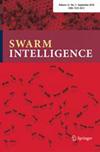基于力的群体协作研究
IF 2.1
4区 计算机科学
Q3 COMPUTER SCIENCE, ARTIFICIAL INTELLIGENCE
引用次数: 20
摘要
协作操作是人类群体、动物群体和许多机器人应用中的一项基本技能。除了是一个有趣的挑战之外,为了实现更高的可扩展性和更简单的硬件和软件设计,无通信方法已应用于机器人组。提出了一种适用于地面和漂浮系统的机器人协同操作物体的通用模型和控制律。该控制方法采用了领导-跟随方案,并且仅基于隐式通信(即接触力的感知)。控制目标主要是将被机器人群操纵的物体以协作的方式引导到期望的位置和方向。对于只有一个先导的系统,我们给出了平衡构型及其稳定性的分析结果,然后通过数值模拟验证了这些结果。从物体位置和方向收敛到期望值的角度讨论了物体内力(由机器人通过接触力引起)的作用。我们还讨论了通过全面的数值分析研究的受控系统的附加特性,即当目标在非理想条件下受到外部干扰时系统的鲁棒性,以及群体中领导者的数量如何影响上述收敛性和鲁棒性。本文章由计算机程序翻译,如有差异,请以英文原文为准。
A study on force-based collaboration in swarms
Cooperative manipulation is a basic skill in groups of humans, animals and in many robotic applications. Besides being an interesting challenge, communication-less approaches have been applied to groups of robots in order to achieve higher scalability and simpler hardware and software design. We present a generic model and control law for robots cooperatively manipulating an object, for both ground and floating systems. The control method exploits a leader–follower scheme and is based only on implicit communication (i.e., the sensing of contact forces). The control objective mainly consists of steering the object manipulated by the swarm of robots to a desired position and orientation in a cooperative way. For a system with just one leader, we present analytical results on the equilibrium configurations and their stability that are then validated by numerical simulations. The role of object internal forces (induced by the robots through contact forces) is discussed in terms of convergence of the object position and orientation to the desired values. We also present a discussion on additional properties of the controlled system that were investigated using thorough numerical analysis, namely the robustness of the system when the object is subject to external disturbances in non-ideal conditions, and how the number of leaders in the swarm can affect the aforementioned convergence and robustness.
求助全文
通过发布文献求助,成功后即可免费获取论文全文。
去求助
来源期刊

Swarm Intelligence
COMPUTER SCIENCE, ARTIFICIAL INTELLIGENCE-ROBOTICS
CiteScore
5.70
自引率
11.50%
发文量
11
审稿时长
>12 weeks
期刊介绍:
Swarm Intelligence is the principal peer-reviewed publication dedicated to reporting on research
and developments in the multidisciplinary field of swarm intelligence. The journal publishes
original research articles and occasional review articles on theoretical, experimental and/or
practical aspects of swarm intelligence. All articles are published both in print and in electronic
form. There are no page charges for publication. Swarm Intelligence is published quarterly.
The field of swarm intelligence deals with systems composed of many individuals that coordinate
using decentralized control and self-organization. In particular, it focuses on the collective
behaviors that result from the local interactions of the individuals with each other and with their
environment. It is a fast-growing field that encompasses the efforts of researchers in multiple
disciplines, ranging from ethology and social science to operations research and computer
engineering.
Swarm Intelligence will report on advances in the understanding and utilization of swarm
intelligence systems, that is, systems that are based on the principles of swarm intelligence. The
following subjects are of particular interest to the journal:
• modeling and analysis of collective biological systems such as social insect colonies, flocking
vertebrates, and human crowds as well as any other swarm intelligence systems;
• application of biological swarm intelligence models to real-world problems such as distributed
computing, data clustering, graph partitioning, optimization and decision making;
• theoretical and empirical research in ant colony optimization, particle swarm optimization,
swarm robotics, and other swarm intelligence algorithms.
 求助内容:
求助内容: 应助结果提醒方式:
应助结果提醒方式:


